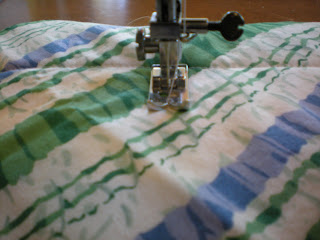Sewing the Sandwich Squares
Step two is fun, but can take a bit of time. I am an all or nothing sewer, so unless I can finish a whole process at one time, I don't start it. It does make it easier now that I have a designated sewing area, not the kitchen table, but I still don't like to have fabric all over the place.
First, do some ho-hum maintenance and sample stitches. Clean out all the fuzz blobs. Check the tension, sewing with some saved fabric and batting. I am boring with thread, I use white or cream, period. I'm sure you could get really fancy with coordinating thread that would really pop, but I stick with the basics. I use cotton covered polyester thread, but any basic thread will do. Save time, load extra bobbins now. Remember to use a fresh needle if it has been a while. When I make a memory quilt I have to switch to a denim needle.
*Update* I asked some other rag quilters on Etsy which thread they use, and they said 100% cotton Coats and Clark Machine Quilting Thread, not the cotton covered polyester I use. I use Coats and Clark also, but I was using the Hand Quilting Thread. With that endorsement, I may switch.
Then start sewing the Xs. Don't pull, don't push, let the sewing machine do the work. It wants to sew straight, just guide the fabric. With rag quilts it is wrong side to wrong side, probably not how you learned from your Mom or from sewing class. Sew from corner to corner, getting as close as you can, but perfection is not necessary.
You don't need to finish both sides of the Xs at once. You can "daisy chain" square after square, just sewing the first part of the X. You can do this in batches of 10, 20 or as many squares as you like, building up a pile of them behind the machine. When you finish as many as you like, trim the thread between the squares and re-stack them for the next part of the X.
Now sew the rest of the X, daisy chaining as you go. If it looks crooked, or the stitch tension is getting wacky, decide how much it will show on the finished quilt. The lighter and busier the fabric, the less your boo-boos will show. Mistakes show up the most on vibrant and dark fabrics.
If you have any goofies, squares with 2 different fabrics front and back, put a pin in them now so you won't forget when you are deciding on your layout.
When you are done, you can bag or box up the squares for another time, day, month, year. By now I am usually shocked at the time and the house is needing some TLC. I clean up all the threads on the floor, put my tools away, reintroduce myself to my husband and dog, rehydrate and STRETCH.
Next step will be the layout, my very favorite part of this whole process.






